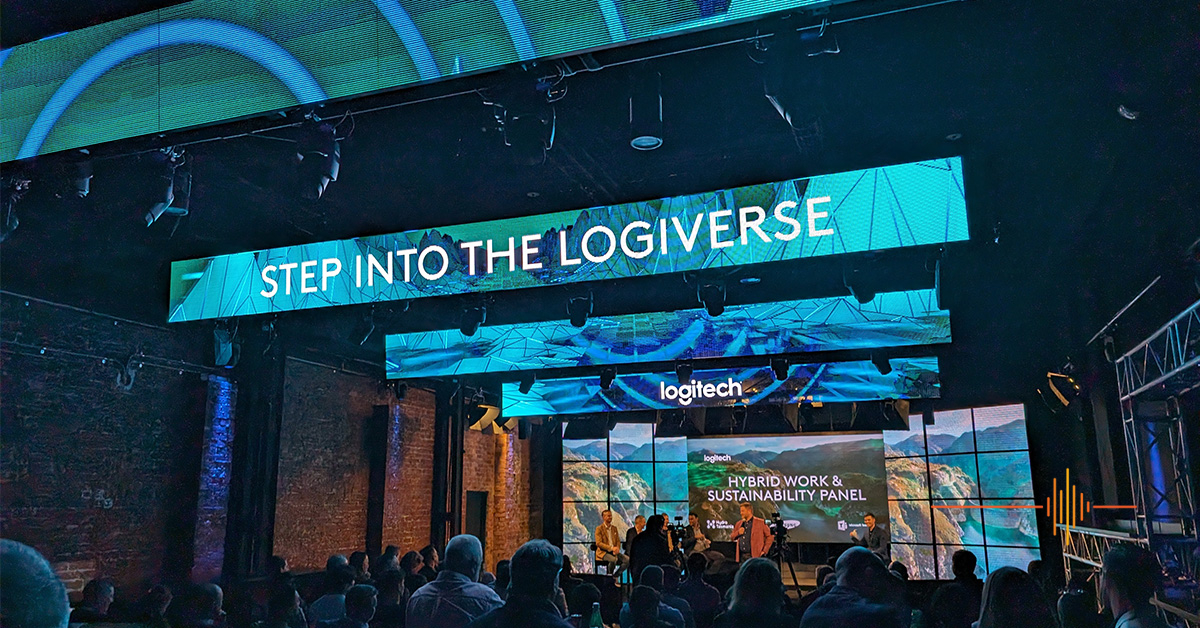No process operates in a vacuum and every action has a reaction. Unlike Newton’s third law of motion, where for every action there is an equal and opposite reaction, in the space of hybrid work and environmental sustainability it is more akin to dropping a pebble into a pond and watch the ripples fan out.
Last week I was privileged enough to be invited to step into the Logiverse and listen to their panel discuss hybrid work and sustainability.
The panel featured three vendors and a client:
- Heath Clark, Manager of IT Operations at Hydro Tasmania
- Lee Edgerton, Regional Partner Development Manager at Microsoft Asia
- Phil Gaut, Senior Director at Samsung Australia
- Mani Nathan, Head of B2B Channels at Logitech
On face value, hybrid work and sustainability are two circles on a Venn Diagram. But diving deeper, there is an intersect. Certainly lots of questions have been asked in the corporate space, and essentially all tenders and RFQs (Request for Quotes) demand some sort of response, whether it is genuinely applicable or not. The conclusion is unmistakable: customers are expecting sustainability commitments from everyone.

Environmental Sustainability
Covering off the sustainability component of the session, Logitech had some interesting insights during their presentation.
Logitech has been publishing their sustainability report for fourteen years.
To date, two out of three Logitech products are shipped in recycled material packaging, and has a label on the back to provide consumers with information on the net carbon emissions in the making of the product.
Of course, I went straight to the packaging of the Logitech Signature Slim Combo that I recently reviewed. The label on it says it’s a certified carbon neutral product.
It is Logitech’s goal, by 2025, to have carbon labelling for all their products. The motive behind it is to make it as simple as checking for the sugar content on a snack you buy in a supermarket. You turn the product around and just read the label on the back. This way, with Logitech products, consumers can make an informed decision based on the environmental impact as a result of the manufacturing process.
Logitech have embedded the sustainability concept from commencement of design all the way to the logistics of getting the product onto the consumer’s desk. Some 60% of their products are now made with second life plastics, purchased from landfills and saved from being buried into the ground.
However, Logitech is not a one trick pony relying on recycled materials to improve on their sustainability commitments. They are continuing to deliver software updates to older devices to extend their useful lifespan. Whilst there are hardware limitations, Logitech is leveraging software to keep these products relevant for longer.
Hybrid Work
The COVID pandemic caused a significant shift in the work paradigm. Phil Gaut from Samsung made a comparison between a workstation and a workplace.
In essence a workstation can be anywhere, but a workplace is where your people gather and work collaboratively, such as an office. Since COVID, the challenge is to incentivise staff to come into the office.
In some of my experiences with the post COVID hybrid world, some companies automatically reverted to the old ways of conducting business. Staff has to be in the office or they will not be productive. But this just leads to staff not feeling trusted by their employer, and reduced outputs. The horse has well and truly bolted. If your staff kept your business alive through COVID and working fully remotely, then a hybrid option is not going to be world ending for your business.
Conversely, Samsung states that for some of their operational requirements they do need people in the building. The challenge then is to implement a fair and equitable scheme that allows everyone to fully engage in the work culture regardless of where they are.
Logitech stated that they have found staff take 18% less days off when given the hybrid work option. Microsoft has a standing pre-approved up to 50% of hybrid work time.
The results are that staff retention has improved, and there is a trust between management and staff that the work will be done. Further, Logitech has reduced their real estate space requirements by a staggering 60%.
If you are looking for a hard return on your bottom line, that is a mind-boggling figure.
This leads to another problem posed to the panel: how will the offices be outfitted?
There is an emphasis on understanding the use of office space. Rather than creating from a template of meeting rooms and desks, there is now a focus on data. How often are meetings held in rooms? How many participants on average? Are we holding large conferences or more one-on-ones? Is the available space being use effectively?
What works for now may not suit a year or half year down the track. The panel all agree that agility is key, and companies must be prepared to redeploy and morph their workspaces to suit the culture. Throw out all the old preconceived notions of how office layout should be and respond to the needs of the business.
Remote work
The proliferation of personalised conferencing as a result of COVID also changed the way businesses with geographical separations function.
Hydro Tasmania has many power generating plants all around Tasmania, and offices in both Melbourne and Tasmania. With the help of Logitech, they have conferencing systems in all their sites, allowing each location to connect with each other and function collaboratively.
It is a standardised approach that levels the playing field regardless of where you are. The entire infrastructure can be managed centrally or from a single point of management. Updates can be deployed, devices can be restarted, and IT can troubleshoot everything all remotely.
Having spent a bit of time working with Melbourne Water in my career, I can appreciate the Logitech solution that is available today. Especially compared to some two decades ago, where the challenges of a far-flung empire of offices with critical systems that needs to be in the fold and maintained meant a lot of time on the road.
As Logitech pointed out during the panel, hybrid work has also changed the way businesses work internally, and how B2B (Business to Business) works. It’s worth noting that by just cancelling one business trip, businesses can save enough to deploy one room of Logitech video conferencing equipment.
Certainly, in my work, there has been a much wider acceptance of conducting product demonstrations via video conferencing. The attendance rate per client has significantly increased when they can attend it from anywhere, be it their office, their home or from the café if they so wish. The flexibility means people are not committed for hours to travel, and being taken from their tasks.
The Future
No panel is worth their salt without some crystal ball gazing. To no one’s surprise, AI is on everyone’s lips.
The quote that comes to mind is JFK in his Inaugural Address in 1961, “ask not what your country can do for you; ask what you can do for your country.” In the vein of AI, the panel’s thoughts were not what AI can do, but what can be done with the AI tools now being provided.
For sustainability, there is a train of thought to make old hardware work better with AI enhanced software. After all, aging hardware does not necessarily make them obsolete on the spot.
There is also a focus on the interconnect between hardware and software, as well as building grids and device controls. By leveraging AI and data, little efficiency gains can be achieved with something as simple as knowing when is the optimal time to run your dishwasher to take advantage of the cheapest electricity rates.
What are my thoughts?
Being able to hybrid work has been a life saver for me for the past few years. With a blended family, every child at a different school, appointments, extracurricular activities, et al, not being office bound is a blessing.
I do miss the organic flow of working in the office, where the conversations are less formal than picking up the phone and calling for a purpose then moving to social. The trade-off of missing the office banter is the substantial potential gains in efficiency, but that said, it does require self-discipline.
As for the future, I have to agree with the panel that the AI on offer is just a raw tool ready to be used. It is an exciting (and scary) future and I am confident that, as always, regulations will lag far behind innovations. After all, we would be lucky if our law makers have a grasp of the issues, let alone understand all the intricacies.
Lastly, I think we are reaching a point where the “program is only as smart as the person who made it” stops holding true. AI starts off being constrained by the data set it is trained on. But without the appropriate human interventions in place to correct assumptions and mistakes made by AI, we are heading down a slippery slope of misinformation. We are already existing in a world filled with misinformation, perhaps a way to look at it is “influencers on steroids“. Just look at the dozens of replies on most posts on X where, surely, AI is spamming every one with alternate videos and naffy comments to “integrate” and start conversation. Let me coin a new term for this – “AIfluencers“.
DRN would like to thank Logitech for the invitation to the Logiverse, Hybrid Work and Sustainability Panel. And my kids and partner says mucho thanks for the swag.





